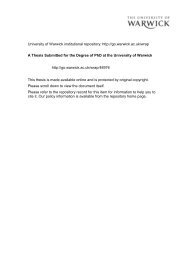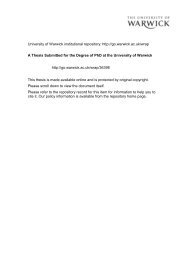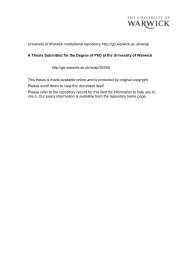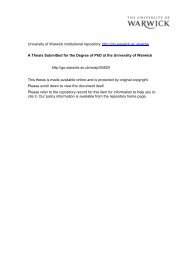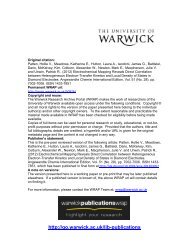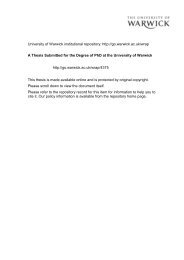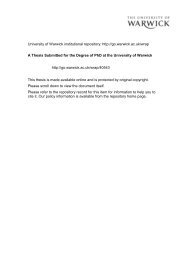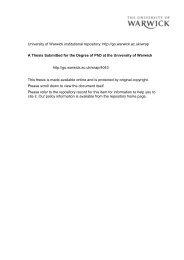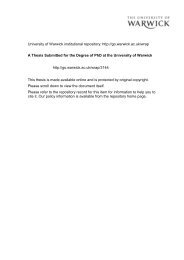Download (13Mb) - WRAP: Warwick Research Archive Portal ...
Download (13Mb) - WRAP: Warwick Research Archive Portal ...
Download (13Mb) - WRAP: Warwick Research Archive Portal ...
You also want an ePaper? Increase the reach of your titles
YUMPU automatically turns print PDFs into web optimized ePapers that Google loves.
most troubling ofall boundary crossings.<br />
The motif of the journey, however, as a fantastic catalyst, often becomes an<br />
encounter not with the completely unknown, but with the margins of the familiar.<br />
Listing some themes typical of the fantastic Ceserani begins with the idea of the<br />
border:<br />
Ecaratteristica del fantastico non allontanarsi troppo dalla cultura dominante e<br />
andare piuttosto a cercare Ie aree geografiche un po' marginali dove si colgono<br />
bene i rapporti fra una cultura dominante e un'altra che si sta ritirando, dove si<br />
vedono i modelli culturali a confronto e in compresenza. 0 addirittura il nuovo<br />
modo va a cercare Ie aree di frontiera dentro di noi, nella vita interiore, nella<br />
stratificazione culturale all'intemo dei personaggi che ormai appartengono alla<br />
cultura dominante'"<br />
Ceserani cites the example of the educated, enlightened nineteenth century man who<br />
finds himself faced with the necessity of acknowledging possible truths of old<br />
schemes of thought. However a consideration of his model of conflict between old<br />
and new cultures might also suggest the tension between patriarchy and an<br />
increasingly female input into culture. Edges and barriers which delimit the familiar<br />
are also the occasions of its rupture and if woman herself has been used to define the<br />
limits ofexperience, then she can also actively define them. This dovetails with Lucie<br />
Armitt's suggestion that the fantastic text,<br />
endlessly open and thus non-containable [...] must therefore pose as a dangerous<br />
threat to established notions of fixity and conformity, a characteristic that<br />
obviously makes the fantastic a particularly appealing form for the exploration<br />
ofsocio-political marginality and ex-centricity.84<br />
Through its uncanny affects, Rimondi even sees the fantastic as constituting a<br />
temporary break: through the symbolic order to reveal 'uno spazio di verita.,85<br />
Kristeva has built upon Lacanian theory to establish the relationship between<br />
the symbolic order and the semiotic, suggesting that women have a privileged<br />
relationship with the semiotic stage, which they have to abandon to join the Law of<br />
the father. The fantastic is generally recognised as offering a mode of breaking<br />
after quotations in the text and denoted TU.<br />
83 Remo Ceserani, p.20.<br />
84 Lucie Annitt, Pushing Back The Limits: The Fantastic as Transgression in Contemporary Women's<br />
Fiction (doctoral thesis, University of<strong>Warwick</strong>, 1992), p.ll.<br />
8S Giorgio Rimondi, 'Dall'Unheimlich all'oggetto a' in Geogrofia, storia e poetiche del fantastico ed.<br />
by Farnetti, pp.165-176 (p. 176).<br />
30




